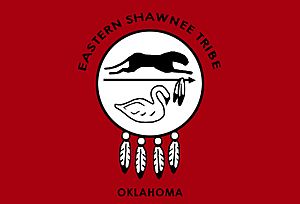Eastern Shawnee Tribe of Oklahoma facts for kids

Tribal flag
|
|
| Total population | |
|---|---|
| 3,652 | |
| Regions with significant populations | |
| Languages | |
| Shawnee, English | |
| Religion | |
| Christianity, traditional tribal religion | |
| Related ethnic groups | |
| Absentee-Shawnee Tribe of Indians of Oklahoma, Shawnee Tribe, and Sac and Fox |
The Eastern Shawnee Tribe of Oklahoma is one of three officially recognized Shawnee tribes. They are located mainly in Oklahoma and Missouri.
The tribe holds a special event called a powwow every September. This gathering takes place at their tribal complex and is a time for celebration, dancing, and cultural sharing.
Contents
Tribal Government and People
The main office for the Eastern Shawnee Tribe is in Wyandotte, Oklahoma. Their special tribal area is in Ottawa County, Oklahoma. There are 3,652 members in the tribe. About 904 of them live in Oklahoma. Some members also live nearby in Missouri. The tribe has a Cultural Preservation Center in Seneca, Missouri.
Glenna J. Wallace has been the elected chief since 2006. She is the first woman to be chief of the tribe. She serves a four-year term. The Eastern Shawnee Tribe also creates its own vehicle tags for tribal members.
To become a member of the tribe, you need to show that you are directly related to people listed on the Dawes Rolls. These were official lists of Native Americans made a long time ago. The tribe does not require a certain amount of Native American ancestry, known as "blood quantum."
How the Tribe Supports Itself
The Eastern Shawnee Tribe works hard to create jobs and support its members. They have their own housing authority, which helps tribal members find homes.
The tribe also owns or co-owns several businesses. These include half of the People's Bank of Seneca, Missouri, a print shop, and a recycling center called Four Feathers Recycling. They also run three casinos, a hotel, a bingo hall, a gas station, and a truck stop. These businesses bring in a lot of money. Experts say their businesses add about $164 million to the economy each year.
A Look at Shawnee History
The Eastern Shawnee Tribe of Oklahoma are mostly descendants of Shawnee people who lived in Ohio until the 1830s. The Shawnees were an Eastern Woodland tribe. They used to travel a lot and lived in many places. These areas include what is now Ohio, Virginia, West Virginia, Western Maryland, Kentucky, and Pennsylvania.
In the late 1700s, more and more European-American settlers moved onto Shawnee lands. Because of this, one group of Shawnees moved to Missouri. They later became the Absentee Shawnee tribe.
By 1817, the Shawnees were given three reservations in Ohio. These were Wapakoneta, Lewistown, and Hog Creek. In 1830, the Indian Removal Act was passed. This law forced many Native American tribes to move west. In July 1831, the Lewistown group, who lived with some Senecas, moved to Indian Territory. This area is now part of Oklahoma. They were known as the "Mixed Band" of Senecas and Shawnees. Another group, who would become the Shawnee Tribe, moved to Kansas in August 1831.
In 1832, the U.S. government set aside about 60,000 acres of land for the "Mixed Band." This land was taken from Cherokee lands in Indian Territory. In 1867, a new agreement was made between the U.S. and the Seneca and Shawnee. This agreement allowed parts of their land to be used by other tribes. It also made the Seneca and Shawnee tribes independent again. The Shawnees from the "Mixed Band" then became the Eastern Shawnee Tribe. The Eastern Shawnee officially became a federally recognized tribe in 1936. This happened under the Oklahoma Indian Welfare Act.
In May 2019, the Eastern Shawnee ceremonial grounds experienced heavy flooding. Water was three feet deep in some areas. Many families had to leave their homes. Local roads were blocked for weeks. The tribe has also had problems with mold because of the flooding. Tribal leaders have joined the city of Miami to speak out. They are against higher water levels at Pensacola Dam and Grand Lake. They believe that when water backs up in the Neosho River, it causes more flooding in their communities.
The Tribal Flag
The Eastern Shawnee Tribe's flag is red. It shows their tribal seal in the middle. The name of the tribe is written in black letters. The seal looks like a warrior's shield. It features a Florida panther. The panther shows cleverness and strength. It also represents Tecumseh, a very important Shawnee leader.
A spear goes through the seal. Below it is a swan. The swan stands for peace, harmony, and beauty. There are four eagle feathers on the flag. These feathers represent the four directions. Originally, there were five feathers on the flag. These stood for the five original Shawnee tribal groups.
Famous Eastern Shawnee People
- J. R. Conrad (born 1974), a player in the National Football League
- Moscelyne Larkin (1925–2012), a famous ballet dancer
- Taylor M. Wright (born 1993), a U.S. Army Officer
- Thomas Captain Chief (1850–1920)
- Thomas A Captain Chief (1884–1980)

